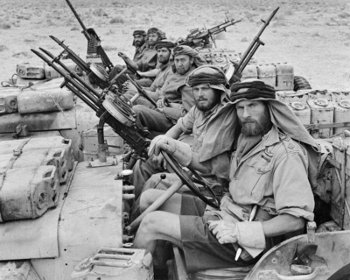History of the SAS Regiment

The Special Air Service (SAS) Regiment’s history dates back to the early 1940s when David Stirling formed a special service unit that was named L Detachment, Special Air Service Brigade. The foundation of this unit (its name was deliberately chosen to be misleading in order to make the Axis forces think that it is a paratrooper brigade in North Africa) on 1st July 1941 is considered the foundation date of the SAS Regiment although it was disbanded after the end of the war.
The L Detachment, Special Air Service Brigade that was commanded by Stirling was founded as a commando unit which would operate behind the German lines in North Africa. The first mission of the unit during the Operation Crusader in Egypt and Libya in the late 1941, however, was a failure and about one third of the unit was killed or captured by the Germans. But its second mission a few months later was a success. Supported by the Long Range Desert Group (LRDG), the unit carried out a raid on Axis airfields in Libya during which they destroyed a large number of aircraft without losing a single man.
In September 1942, the L Detachment, Special Air Service Brigade was renamed as the 1st SAS Regiment which besides four British squadrons also consisted of the Special Boat Section (SBS) and one Greek and one Free French squadron. The unit continued to operate in North Africa but it also carried out several actions in Greece. In early 1943, the founder and commander of the unit, Stirling was captured by the Germans in Libya. He spent the rest of the war in German captivity and was replaced by Paddy Mayne as commander of the 1st SAS. The unit, however, was shortly thereafter reorganized into the Special Raiding Squadron under the command of Mayne and the Special Boat Squadron which was commanded by George Jellicoe. Mayne’s unit was used for operations in Sicily and Italy along with the 2nd SAS that was founded in North Africa in the same year, while the Special Boat Squadron was used for operations in Dodecanese and the Aegean Islands. In 1944, the 1st and 2nd SAS, the Belgian 5th SAS and the French 3rd and 4th SAS were joined into the SAS Brigade which operated behind the enemy lines in France and conducted supportive operations during the Allied advance towards Germany.
The SAS Brigade was disbanded shortly after the end of the Second World War. But less than one year after its disbandment, the British government determined that the country needs a commando unit such as the SAS Brigade and decided to raise a new SAS Regiment as a part of the Territorial Army. The new (21st) SAS Regiment was officially founded on 1 January 1947 and moved to the former Artists Rifles’s headquarters at Dukes Road, Euston. Soon, however, the need for Regular Army SAS regiment occurred. In 1952, the B Squadron, also known as the Malayan Scouts was renamed into the 22nd SAS Regiment and officially added to the British army list. In 1959, a third - 23rd SAS Regiment was created as a part of the Territorial Army.